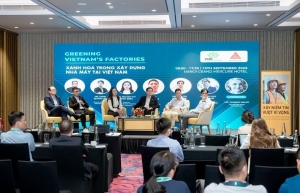Task obvious for Vietnam’s green building development
 |
| There are currently around 300 green buildings certified by standards such as Lotus, Edge, LEED, or Green Mark, Photo: shutterstock |
According to Douglas Lee Snyder, executive director of the Vietnam Green Building Council, from a legal perspective, realising both financial and non-financial incentives in Vietnam is a challenge.
“Maybe we need to make inter-ministerial cooperation efforts to achieve the goals set by the government of Vietnam. For example, while public green buildings often lead the market in other countries, in Vietnam, cost norms per square metre regulated by the Ministry of Finance alone are not enough for one construction, but it needs collaboration from other related ministries,” Snyder told VIR.
Meanwhile, Angus Liew, chairman of Gamuda Land Vietnam, said that the barriers involve technology, equipment, and even perceptions.
“In addition, Vietnam’s government has become well aware of the repercussions and understands the importance of transforming its urban cities to be smarter and more sustainable. To promote the creation of green buildings, we need stronger support from the government through the system of policies and the efforts of developers in innovating energy-efficient solutions,” Liew said.
According to Hoo Swee Loon, deputy general director of Le Mont Group, developing industrial real estate projects according to environmental, social, and governance (ESG) standards is still a fairly new trend in Vietnam.
“Therefore, the implementation will face many challenges, of which, the first difficulty is finance and initial investment. ESG investing often requires some large initial finances to implement greener technologies and equipment, as well as set up a monitoring and management system,” Loon said.
Although the State Bank of Vietnam has made moves to open green credit, up to now, implementing procedures to disburse green credits is still very difficult.
As of the end of 2022, outstanding credit for green projects only accounted for 4.2 per cent of the total outstanding debt of the entire economy and focuses on the fields of renewable energy, clean energy, and green agriculture.
At the annual Vietnam Business Forum held in March, Michele Wee, CEO of Standard Chartered (Vietnam), requested that the government promote the development of green credit.
“The legal corridor is also an obstacle to accessing green capital for Vietnamese businesses. If the legal framework is standardised, banks will have an easier time lending to green projects,” Wee said.
“In addition, innovation in operations management, monitoring, and measurement capabilities as well as training and human resources are also difficulties that investors face in the process of implementing green projects.”
According to the Ministry of Construction’s statistics, as of mid-2023, there are currently nearly 300 green buildings evaluated and certified by standards such as Lotus, Edge, LEED, or Green Mark with a total construction floor area of about seven million square metres.
Vietnam currently ranks 28th in the world in the number of LEED-certified green buildings. The number is deemed modest compared to the number of projects built and put into operation and compared to the potential and requirements for economical use of energy and resources, as well as environmental protection.
 | Vietnam ranks 28th worldwide in terms of green buildings With over 250 LEED-certified constructions over the last decade, Vietnam is increasingly demonstrating the relevance of green aspects in architectural design, operations, and the maintenance of existing buildings. |
 | Vietnam promotes shift to green production lines Investment in green factories is one of the first steps on the road to greening production lines, according to Douglas Lee Snyder, executive director of the Vietnam Green Building Council (VGBC). |
 | Vietnam's 300 certified green buildings yet to reach net-zero As Vietnam intensifies its focus on sustainability, the nation's progress is spotlighted with a modest tally of 300 certified green buildings. To date, no building in Vietnam has been designed, constructed, or managed to meet net-zero criteria. |
What the stars mean:
★ Poor ★ ★ Promising ★★★ Good ★★★★ Very good ★★★★★ Exceptional
Related Contents
Latest News
More News
- The Kross ascends in Ho Chi Minh City's business heart (October 10, 2025 | 17:16)
- ESG-driven sustainability to define Vietnam’s green real estate (September 19, 2025 | 11:35)
- Tan Thuan Tower open for high value-added and innovative tenants (September 10, 2025 | 10:00)
- The new home of modern business at Hanoi's Starlake (August 19, 2025 | 08:00)
- Forum focuses on financial solutions for ESG in real estate (June 18, 2025 | 12:12)
- Frasers Property Vietnam moves towards green real estate leadership (May 08, 2025 | 11:25)
- Keppel collaborates with leading brands to enhance urban living in Vietnam (April 04, 2025 | 09:26)
- Strengthen partnership and efforts to promote zero energy buildings in Vietnam (February 26, 2025 | 17:31)
- Haus Dalat ESG real estate project holds opening ceremony (February 24, 2025 | 11:12)
- Best golfers awarded at Swing for the Kids 2024 (October 13, 2024 | 08:00)

 Tag:
Tag:





















 Mobile Version
Mobile Version